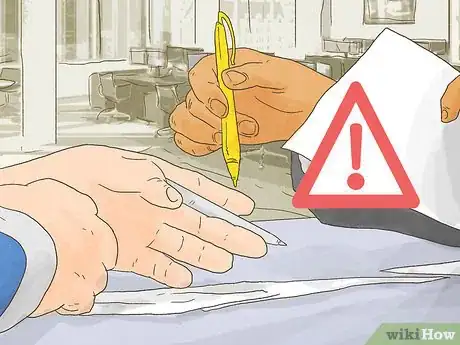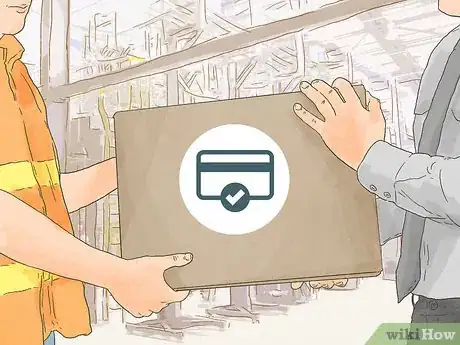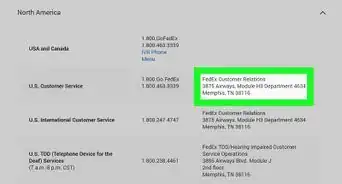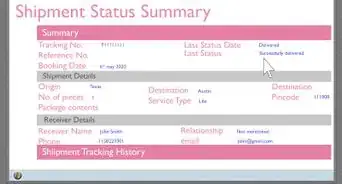This article was co-authored by wikiHow Staff. Our trained team of editors and researchers validate articles for accuracy and comprehensiveness. wikiHow's Content Management Team carefully monitors the work from our editorial staff to ensure that each article is backed by trusted research and meets our high quality standards.
This article has been viewed 22,890 times.
Learn more...
Whether your business has international customers or you just need to send a gift to a remote relative, you might need to know how to ship internationally. There are several things to think about when your shipment needs to cross borders, such as customs costs and international laws. After that, preparing your shipment is similar to when you ship domestically.
Steps
Handling Customs and Laws
-
1Check shipping restrictions. Depending on where and what you’re shipping, your shipment may be subject to restrictions on size, amount or weight. Some products might not even be allowed in the country you’re shipping to. Some restrictions are represented by a country’s laws, whereas others are imposed by shipping services. It’s important to check with your local postal service to determine these restrictions.
- Restrictions aren’t always obvious. For example, Vietnam doesn’t allow the importation of calendars. It’s always better to check rather than assuming there are no restrictions on your shipment.[1]
-
2Fill out necessary customs documents. Customs documents are required whenever goods cross borders. The form itself will vary depending on the destination country, but almost all need information on the sender, recipient, and the shipment itself. The form will usually need you to specify what you’re shipping and its value. This is to determine if any customs or duty fees apply to your shipment.
- Your local postal service will usually have the customs forms you need on hand, and are usually able to help you complete them.
- Be as specific as you can when describing the contents of your shipment.[2]
Advertisement -
3Place your custom documents in the correct spot. Some custom documents need to be placed in your shipment, while others need to be stuck on the outside, somewhere visible. Make sure you know which is needed, so you’ll know how to include it in your shipment.[3]
-
4Research customs and duty costs. It’s important to know these fees ahead of time, so you can factor them into your budget or charge them to your recipient. A quick google search including the destination for your shipment can help you find online databases or calculators to figure out these fees.[4]
-
5Make sure the recipient’s contact information is accurate. If your package ends up being held at customs, border agents may want to contact the recipient. You may also want to get in touch with your recipient throughout the shipping process if there are any issues. Get the recipient’s phone number and email address and doublecheck them for any typos or mistakes.[5]
-
6Consider hiring a customs broker. This is especially important if you’re shipping commercial goods or ship across borders regularly. A customs broker will serve as a liaison between you and the customs authorities in the destination country. They not only can help make sure your shipment abides by all applicable laws and regulations, but they can help you determine duty and other fees.
Packaging Your Shipment
-
1Choose a bubble mailer for smaller items. The packaging you choose will depend on the weight and size of your shipment. Postal services have strict limits on what you can and can’t ship in a standard letter envelope. You may be able to use a bubble mailer for smaller items. These are slightly larger than standard envelopes that are lined with bubble wrap.[6]
-
2Use a durable box for larger items. If you can’t fit your item in a bubble mailer, get a box. The right size box will protect your item much like a bubble mailer would, but gives you more flexibility on size.
- When choosing a box for your shipment, make sure it’s not damaged. Any bends or tears will prevent it from adequately protecting your shipment.
- Make sure to leave enough room in the box for cushioning materials, such as foam peanuts.[7]
-
3Provide ample protection for your shipment. This is especially important if you’re shipping something fragile. Make sure your item is packaged snugly, with cushioning materials on all sides, including underneath and above.
- Choices for typical cushioning materials include air bags, bubble wrap and foam peanuts. In a pinch, you can even use newspaper.
- If you need to include an invoice or customs form in your package, make sure to place it on top of the cushioning materials, where it’s easily visible.[8]
-
4Seal your shipment. For envelopes, you either need to lick the sealing strip or peel back the protective film on an adhesive strip. For boxes, make sure you use packaging tape. Use a strip to seal the flaps together, then use more tape around the top of the box.[9]
Sending Your Shipment
-
1Address and label your shipment. Make sure the recipient’s address is included in its entirety and clearly visible. Don’t forget to include the postal code and any apartment or suite numbers. Include your address as well, so the shipment can be returned to you if there are any issues.
- Some customs documents need to be stuck on top of your shipment. If that’s the case, make sure it doesn’t obscure either address.
- It’s a good idea to include phone numbers and email addresses for both yourself and your recipient. That way, you can be contacted if there are any problems along the way.[10]
-
2Get a tracking number. Most postal services will offer the ability to track your package. This allows you to follow along online, knowing exactly where your package is. This is crucial for international shipping; you’ll know if your package ends up stuck at customs.
- If you’re shipping an item to a customer, you should provide them with the tracking number.
-
3Choose a shipping carrier that balances services and cost-effectiveness. Select a postal service that reflects your needs. Options you can pay for include tracking information, signature on delivery and insurance against damage or loss. All these features involve and extra cost, so make sure to select those most pertinent to your situation.[11]
-
4Send your shipment. You can use your country’s postal service or private shipping companies. Compare their costs and pick the company that’s most cost efficient for your needs.
Warnings
- Be careful shipping dangerous goods such as ammunition or fireworks. Many postal services won’t accept packages containing these.⧼thumbs_response⧽
References
- ↑ http://www.practicalecommerce.com/5-Quick-Tips-for-Shipping-Internationally
- ↑ https://smallbusiness.fedex.com/international/how-to-ship.html
- ↑ https://smallbusiness.fedex.com/international/how-to-ship.html
- ↑ https://www.ups.com/us/en/help-center/shipping-support/how-to-ship-internationally.page
- ↑ https://www.ups.com/us/en/help-center/shipping-support/how-to-ship-internationally.page
- ↑ https://www.ups.com/us/en/services/individual-shipper/preparing-to-ship.page
- ↑ https://www.ups.com/us/en/services/individual-shipper/preparing-to-ship.page
- ↑ http://www.tis-gdv.de/tis_e/verpack/polster/polster.htm
- ↑ https://www.ups.com/us/en/services/individual-shipper/preparing-to-ship.page







































































